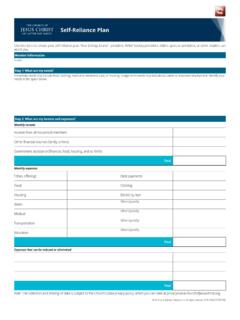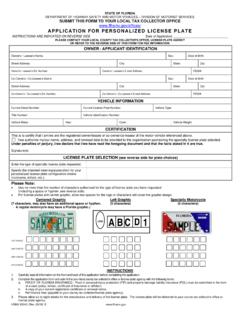Transcription of DRUG NAME: Cyclophosphamide - BC Cancer
1 Cyclophosphamide DRUG NAME: Cyclophosphamide SYNONYM: Cyclo, CPA, CPM, CTX, CYC, CYT COMMON TRADE NAME: CYTOXAN ,1 PROCYTOX , NEOSAR (USA) CLASSIFICATION: Alkylating agent Special pediatric considerations are noted when applicable, otherwise adult provisions apply. MECHANISM OF ACTION: Cyclophosphamide is an alkylating agent of the nitrogen mustard An activated form of Cyclophosphamide , phosphoramide mustard, alkylates, or binds, to DNA. Its cytotoxic effect is mainly due to cross-linking of strands of DNA and RNA, and to inhibition of protein These actions do not appear to be cell-cycle specific. PHARMACOKINETICS: Interpatient variability metabolism; clearance of Cyclophosphamide and its metabolites4 >75%2; manufacturer recommends drug be taken on an empty stomach, but states may be taken with food to decrease GI upset5 Oral Absorption time to peak plasma concentration 1-2 h3 throughout body cross blood brain barrier? to limited extent2 volume of distribution L/kg6 Distribution plasma protein binding7 12-14% of unchanged drug; 67% of total plasma alkylating metabolites6 mainly by microsomal enzymes in the liver.
2 8 cytochrome P450 (CYP) primarily CYP 2B69 active metabolites4 4-hydroxycyclophosphamide, aldophosphamide, phosphoramide mustard, acrolein10 Metabolism inactive metabolites4 4-keto- Cyclophosphamide , carboxyphosphamide, nornitrogen mustard primarily by enzymatic oxidation to active and inactive metabolites, which are mainly excreted in the urine7 urine 5-25% unchanged2 feces 31-66% after oral dose terminal half life7 h ( h) Excretion clearance7 mL/min/kg Gender no clinically important differences found Elderly no clinically important differences found children terminal half life h7; volume of distribution L/kg7 Ethnicity no clinically important differences found Adapted from standard reference11 unless specified otherwise.
3 BC Cancer Agency Cancer Drug Manual Page 1 of 12 Cyclophosphamide Developed: September 1994 Limited Revision: March 2006, August 2006, 1 June 2011, 1 October 2011, 1 June 2013 Cyclophosphamide USES: Primary uses: Other uses: *Breast Cancer Bladder cancer12 Conditioning regimen for stem cell transplant Brain cancer12 Ewing s sarcoma Cervical cancer12 *Leukemia, acute myelogenous Endometrial cancer11 *Leukemia, chronic lymphocytic Gestational trophoblastic neoplasia12 *Leukemia, chronic myelogenous Leukemia, acute lymphocytic12 *Leukemia, pediatric acute lymphoblastic Lymphoma, cutaneous T-cell11 *Lung Cancer Osteosarcoma12 *Lymphoma, Burkitt s Soft tissue sarcoma12 *Lymphoma, Hodgkin s disease Testicular cancer12 *Lymphoma, non-Hodgkin s Thymoma12 Lymphoproliferative disease Waldenstrom s macroglobulinemia12 *Multiple myeloma Wilm s tumour11 *Mycosis fungoides *Neuroblastoma *Ovarian Cancer *Retinoblastoma Rhabdomyosarcoma *Health Canada approved indication SPECIAL PRECAUTIONS: Contraindicated in patients who have a history of hypersensitivity reaction to There is possible cross-sensitivity with other alkylating Carcinogenicity.
4 Secondary malignancies have developed in patients treated with Cyclophosphamide alone or in combination with other antineoplastics. Occurring most frequently are bladder, myeloproliferative and lymphoproliferative malignancies. Secondary malignancies are most common in patients treated initially for myeloproliferative or lymphoproliferative diseases or for non-malignant conditions with immune pathology. Urinary bladder malignancies are most common in patients who experienced hemorrhagic cystitis. Mutagenicity: Because of the mutagenic potential of Cyclophosphamide , adequate methods of contraception should be used by patients (both male and female) during and at least four months after Fertility: Gonadal suppression may occur and sterility can be irreversible in some Age and duration of chemotherapy are the main factors contributing to ovarian For example, treatment with Cyclophosphamide , methotrexate and fluorouracil for six months results in permanent ovarian failure in 70 percent of women over 40 years of age and in 40 percent of younger women.
5 The median time to onset of ovarian failure is shorter in older women than in younger women (2-4 months vs. 6-16 months), and ovarian failure is less likely to be reversible in older women (in about 10 percent vs. up to 50 percent). The rate of permanent ovarian failure is lower with regimens of doxorubicin and Cyclophosphamide than with Cyclophosphamide , methotrexate and fluorouracil. Heart disease: Caution should be used when treating patients with Cyclophosphamide who have pre-existing heart Pregnancy: FDA Pregnancy Category There is positive evidence of human fetal risk, but the benefits from use in pregnant women may be acceptable despite the risk ( , if the drug is needed in a life-threatening situation or for a serious disease for which safer drugs cannot be used or are ineffective). Breastfeeding should be terminated prior to initiating Cyclophosphamide therapy as this drug is excreted in breast BC Cancer Agency Cancer Drug Manual Page 2 of 12 Cyclophosphamide Developed: September 1994 Limited Revision: March 2006, August 2006, 1 June 2011, 1 October 2011, 1 June 2013 Cyclophosphamide SIDE EFFECTS: The table includes adverse events that presented during drug treatment but may not necessarily have a causal relationship with the drug.
6 Because clinical trials are conducted under very specific conditions, the adverse event rates observed may not reflect the rates observed in clinical practice. Adverse events are generally included if they were reported in more than 1% of patients in the product monograph or pivotal trials, and/or determined to be clinically ORGAN SITE SIDE EFFECT Clinically important side effects are in bold, italics anaphylactic reaction15 allergy/immunology nasal congestion when IV doses are administered too rapidly (large doses via 30-60 minute infusion);15 patients experience runny eyes, rhinorrhea, sinus congestion, and sneezing immediately after infusion15 (1-10%) anemia methemoglobinemia with bone marrow transplant (BMT) doses15 myelosuppression; WBC nadir 8-15 days, platelet nadir 10-15 days, recovery 17-28 days blood/bone marrow/ febrile neutropenia thrombocytopenia cardiovascular cardiac dysfunction in high-dose (<1%);15 high-dose can be defined as 60 mg/kg daily or 120-270 mg/kg over a few days;11 manifests as CHF; cardiac necrosis or hemorrhagic myocarditis.
7 Pericardial tamponade (BMT doses)15 coagulation hypoprothrombinemia, risk of bleeding (very rare) asthenia or sweating ( ) constitutional symptoms dizziness15 (<1%) extravasation hazard: none16 alopecia7,15 (40-60%); begins 3-6 weeks after start of therapy facial flushing following IV administration2,15 (1-10%) hyperpigmentation (skin and nails)2,15 (<1%) rash, hives, or itching2,15 (1-5%) redness, swelling, or pain at injection site2,15 dermatology/skin toxic epidermal necrolysis15 (<1%) endocrine hyperglycemia2 emetogenic potential: >1g high moderate; <1g low moderate17 anorexia (33%) diarrhea15 (>10%) hemorrhagic colitis15 (<1%) mucositis15 (>10%) myxedema or sore lips2 ( ) nausea and vomiting are dose-related15: > 90% for >1500 mg/m2, 60-90% for 750-1500 mg/m2, 30-60% for < 750 mg/m2 or oral; usually beginning 6-10 hours after administration gastrointestinal stomatitis2,15 (>10%) hepatic hepatotoxicity15 (<1%) BC Cancer Agency Cancer Drug Manual Page 3 of 12 Cyclophosphamide Developed: September 1994 Limited Revision: March 2006, August 2006, 1 June 2011, 1 October 2011, 1 June 2013 Cyclophosphamide BC Cancer Agency Cancer Drug Manual Page 4 of 12 Cyclophosphamide Developed: September 1994 Limited Revision.
8 March 2006, August 2006, 1 June 2011, 1 October 2011, 1 June 2013 ORGAN SITE SIDE EFFECT Clinically important side effects are in bold, italics jaundice15 (<1%) hyperkalemia, usually in context of tumour lysis15 (<1%) hyperuricemia with high-dose and/or long-term therapy15 (<1%) metabolic/laboratory syndrome of inappropriate antidiuretic hormone (SIADH) causing hyponatremia pain headache2,15 (1-10%) interstitial pulmonary fibrosis, with high-dose and/or long-term therapy15 (<1%) pulmonary pneumonitis, with high-dose and/or long-term therapy15 (<1%) non-hemorrhagic cystitis6 hemorrhagic cystitis (up to 40%)15; with high-dose and/or long term therapy2; severe, potentially fatal renal tubular necrosis15 (1-5%) renal/genitourinary hemorrhagic ureteritis (<1%) secondary malignancy urinary bladder, myeloproliferative, or lymphoproliferative malignancies15 (<1%) sexual/reproductive function interferes with oogenesis and spermatogenesis15 (>10%); may be irreversible in some patients; gonadal suppression (amenorrhea)2 syndromes syndrome of inappropriate antidiuretic hormone (SIADH) secretion with high-dose and/or long-term therapy2,15 (1-5%) Adapted from standard reference1,11 unless specified otherwise.
9 Cardiac toxicity may occur in patients receiving high-dose Cyclophosphamide . High-dose can be defined as 60 mg/kg daily or 120-270 mg/kg over a few Other risk factors for developing cardiac toxicity include previous chest or mediastinal radiotherapy, anthracycline administration, concomitant administration of chemotherapy drugs which are not normally considered cardiotoxic, especially carmustine, cytarabine, and 6-thioguanine,4 and by the presence of left ventricular dysfunction (ejection fraction less than 50%).18 The mechanism may involve direct injury to the endothelium by phosphoramide mustard, an active metabolite of ,19 Unlike anthracyclines, Cyclophosphamide -induced cardiotoxicity does not appear to be ,18,20 In contrast to anthracycline-induced cardiomyopathy which occurs months to years after cumulative doses of anthracyclines, Cyclophosphamide -induced cardiotoxicity occurs much Toxicity has ranged from minor, transient ECG changes and asymptomatic elevation of cardiac enzymes at a total dose of 100 mg/kg to fatal myocarditis and myocardial necrosis at total doses ranging upwards from 144 mg/kg delivered over 4 Clinical signs include dyspnea, tachypnea, fluid retention, increased systemic venous pressure and Patients may experience heart failure, arrhythmias, irreversible cardiomyopathy, pericarditis, or death as a result of Treatment is Hemorrhagic cystitis may occur in up to 40% of patients (especially children )
10 On long term or high dose Cyclophosphamide ,11 Other risk factors for developing hemorrhagic cystitis include rate of infusion, and rate of metabolism of Cyclophosphamide , as well as the hydration status, urine output, frequency of urination, and concurrent exposure to other urotoxic drugs or genitourinary The mechanism may involve direct injury to the urothelium by acrolein, an active metabolite of Hemorrhagic cystitis can develop within a few hours or be delayed several Clinical diagnosis includes non-specific symptoms such as hematuria, dysuria, urgency and increased frequency of urination and can be confirmed using Severe hemorrhagic cystitis can lead to constriction of the bladder, anemia, recurrent urinary tract infection, bladder perforation, renal failure and Longterm complications include bladder fibrosis and contraction, urinary reflux and transitional cell bladder tumours. Non-hemorrhagic cystitis, edema of the bladder and suburethral bleeding can also Cyclophosphamide Prophylactic measures include encouraging patients to drink plenty of fluids during therapy (most adults will require at least 2 L/day), to void frequently, and to avoid taking the drug at Patients should be well hydrated before and for 24-72 hours following As well, Cyclophosphamide should be administered as early in the day as possible to decrease the amount of drug remaining in the bladder With large IV doses, IV hydration is usually The use of mesna and/or continuous bladder irrigation is rarely needed for doses <2 However, mesna has been used in patients receiving Cyclophosphamide for immunologically mediated disorders ( , Wegener s granulomatosis, systemic lupus erythromatosus, dermatomyositis, polyarteritis).













